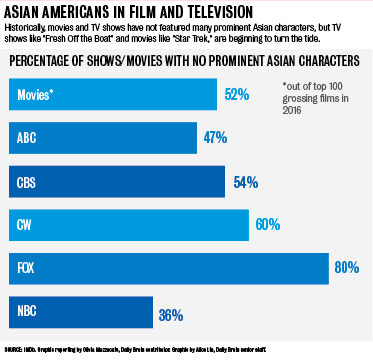Diversity in film and television came into the spotlight in 2016 with #OscarsSoWhite. A USC study in 2016 found only about a quarter of speaking characters belonged to non-white racial/ethnic groups. In “Reel Representation,” columnist Olivia Mazzucato discusses different issues of race and representation in media as they relate to new movies and TV shows.
“Fresh Off the Boat” debuted on ABC in 2015, making it the first American television show about an Asian-American family in 20 years.
I struggled to process that fact. I wasn’t even alive the last time there was a show on television about people who looked like me. Obviously, representation isn’t perfect, but Hollywood has made considerable progress since 1994, when Margaret Cho’s “All-American Girl” held this distinction.
How is it that there’s been almost no change since the last millennium?
More than half of the top 100 grossing films of 2016 feature no Asian characters, and the average percentage is even higher for prime-time television shows. I felt acutely aware of this shortage this week when my roommate and I struggled to come up with a list of Asian characters from recent movies and TV shows. We failed to name more than 10 names.

Asian-American representation is a difficult issue to address because it is multifaceted. Erasure is disguised as a marketing decision; racism is masked as humor. But perhaps the biggest obstacle to representation is the idea that Asian inclusion is unattainable.
It’s easy to look at these obstacles and just want to give up. On rare occasions, we get a character like Hikaru Sulu from the “Star Trek” reboot, who shatters boundaries as a strong, gay Asian character and lives to fight another day. But often, it feels like each new issue is just a rehash of an old problem. We fight the same battles over and over again.
Some aspects of Hollywood are still biased against Asians. Racist humor that makes Asians the punchline is still oddly prevalent – the 2016 Oscars cast Asian children to portray bankers and more recently, Steve Harvey joked about women being repulsed by Asian men.
Films have repeatedly erased Asian characters in a series of casting decisions that feature combinations of whitewashing and modern-day yellowface. Emma Stone starred as a Chinese-Hawaiian character in “Aloha,” and the “Ghost in the Shell” production commissioned visual effects tests to make white background actors look Asian.
The Asian-American characters that do make it to the screen face myriad problems.
[Related: ‘Star Wars’ films bring diversity to Hollywood]
Incredible Asian-American characters, like Cristina Yang from “Grey’s Anatomy” and Glenn Rhee from “The Walking Dead” have disappeared, having been either written off or killed, leaving a gaping void in representation.
Many Asian characters that remain on screen are problematic stereotypes. Raj Koothrappali of “The Big Bang Theory” is awkward and unable to talk to women. Katana from “Suicide Squad” wears a mask with the Japanese flag on it, speaks sparingly and is named after the Japanese sword she carries.
But even more daunting than all of these individual issues is the overwhelming mindset that Asian representation is impossible.
In response to the backlash following Scarlett Johansson’s casting in “Ghost in the Shell,” screenwriter Max Landis posted a video on YouTube titled “If You’re Mad About Ghost In The Shell You Don’t Know How The Movie Industry Works” and claimed that there simply weren’t any A-list Asian celebrities that could have taken the role. Writer Aaron Sorkin made similar statements, complaining that it was difficult to adapt a particular book because there aren’t any Asian movie stars.
[Related: ‘Hidden Fences’ gaffe]
I’m not going to lie and say there are Asian-American equivalents to George Clooney or Julia Roberts. There aren’t. But for some reason, Hollywood seems reluctant to create them or to give them a chance to be legends in their own right.
Reading Sorkin’s comments particularly stung because I’ve seen his ability to craft compelling characters in “The West Wing,” to write roles that propel actors and actresses to fame. He has the credibility and the power within Hollywood, as a writer and as a creator, to elevate Asian actors and actresses.
He shouldn’t have to worry about the lack of Asian movie stars – he can create them.
Sorkin isn’t the source of the problem – he’s simply part of a mindset pervasive throughout the industry. These responses normalize the idea that Asians are not represented realistically, that it is commonplace for their characters to be absent or stereotyped.
Fixing Asian representation cannot happen overnight. Because the issue is so large and complex, there’s no clear path towards equitable diversity. We must fight this perception across the board – both those in positions of power within Hollywood and audiences who vote with their money and ratings.
And maybe someday, “Fresh Off the Boat” won’t be the only TV show about Asian-Americans. Maybe then, my roommate and I won’t have to struggle to name Asian characters.
